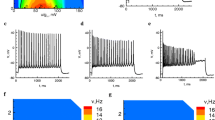Abstract
The effects of antidromic potential spread were investigated in the stretch receptor neurons of the crayfish. Current and potential responses to conductance changes were recorded in the dynamic clamp condition and compared to those obtained by using some conventional clamp methods and a compartmental neuron model. An analogue circuit was used for dynamic calculation of the injected receptor current as a function of the membrane potential and the given conductance change. Alternatively, receptor current responses to a mechanical stimulus were recorded and compared when the cell was voltage clamped to a previously recorded impulse wave form and the resting potential, respectively. Under dynamic clamp, the receptor current had an oscillating waveform which contrasts with the conventional recordings. Frequency, amplitude and sign of the oscillations were dependent on the applied conductance level, reversal potential and electrotonic attenuation. Mean current amplitude and frequency of the evoked impulse responses were smaller under dynamic clamp, especially for large conductance increases. However, firing frequency was larger if plotted against the mean current response. Recorded responses were similar to those calculated in the model. It was not possible to evoke any adaptation in the slowly adapting neuron by using the dynamic clamp. Evoked potential change served as a self limiting response, preventing the depolarization block. However, impulse duration was significantly shorter in the rapidly adapting neuron when the dynamic clamp was used. It was concluded that, in the stretch receptor neurons during a conductance increase, antidromic potential spread modulates the receptor responses and contributes to adaptation.











Similar content being viewed by others
References
Alexandrowicz JS (1951) Muscle receptor organs in the abdomen of Homarus vulgaris and Palinurus vulgaris. Q J Microsc Sci 92:163–200
Brown HM, Ottoson D, Rydqvist B (1978) Crayfish stretch receptor: an investigation with voltage-clamp and ion-sensitive electrodes. J Physiol 284:155–179
Cattaert D, Elmanira A, Clarac F (1994) Chloride conductance produces both presynaptic inhibition and antidromic spikes in primary afferents. Brain Res 666:109–112
Erxleben C (1989) Stretch-activated current through single ion channels in the abdominal stretch receptor organ of the crayfish. J Gen Physiol 94:1071–1083
Goaillard JM, Marder E (2006) Dynamic clamp analysis of cardiac, endocrine, and neural function. Physiology 21:197–207
von Harraveld A (1936) A physiological solution for freshwater crustaceans. Proc Soc Exp Biol 34:428–432
Johnston D, Mia-Sin WD (1995) Functional properties of dendrites. In: Johnston D, Mia-Sin WD (eds) Foundations of cellular neurophysiology. MIT, Cambridge, pp 55–120
Juusola M, Robinson HPC, Polovieja GG (2007) Coding with spike shapes and graded potentials in cortical network. Bioessays 29:178–187
Kumoro T (1981) Fine structural study of the abdominal muscle receptor organs of the crayfish (Procambarus clarkii). Fast and slow receptor muscles. Tissue Cell 13:79–92
Koch C, Segev I (1998) Cable theory for dendritic neurons. In: Koch C, Segev I (eds) Methods in neuronal modeling. MIT, Cambridge, pp 27–92
Loewenstein WR, Terzuolo CA, Washizu Y (1963) Separation of transducer and impulse generating process in sensory receptors. Science 142:1180–1181
Nakajima S, Onedara K (1969) Membrane properties of the stretch receptor neurones of crayfish with particular reference to mechanisms of sensory adaptation. J Physiol 200:161–185
Purali N (2002) Firing properties of the soma and the axon of the rapidly and slowly adapting stretch receptors in crayfish. Gen Physiol Biophys 21:205–226
Purali N (2005) Structure and function relationship in the abdominal stretch receptor organs of the crayfish. J Comp Neurol 489:369–383
Purali N (1997) Mechanism of adaptation in a mechano-receptor. A study of mechanical and ionic factors in the crayfish stretch receptors. Repro Print AB, Stockholm
Purali N, Rydqvist B (1998) Action potentials and sodium current in the slowly and rapidly adapting stretch receptor neuron of the crayfish (Astacus astacus). J Neurophysiol 80:2121–2132
Rall W, Segev I (1985) Space-clamp problems when voltage clamping branched neurons with intracellular microelectrodes. In: Thomas J, Smith G, Lecar H, Redman SJ, Gage PW (eds) Voltage and patch clamping with microelectrodes. American Physiological Society, Bethesda, pp 191–215
Rydqvist B, Purali N (1993) Transducer properties of the rapidly adapting stretch receptor neurone in crayfish (Pacifastacus leniusculus). J Physiol 469:193–211
Spruston N, Jaffe DB, Wiliams SH, Johnston D (1993) Voltage- and space-clamp errors associated with the measurement of electronically remote synaptic events. J Neurophysiol 70:781–802
Swerup C, Purali N, Rydqvist B (1991) Block of receptor response in stretch receptor neuron of the crayfish by gadolinium. Acta Physiol Scand 143:21–26
Swerup C, Rydqvist B (1992) The abdominal stretch receptor organs of crayfish. Comp Biochem Physiol 103A:423–431
Acknowledgements
The author thanks Prof. T. Yorukan for reading the manuscript. This study was supported by the grant from National Research Council of Turkish Republic (SBAG 105s424)
Author information
Authors and Affiliations
Corresponding author
Rights and permissions
About this article
Cite this article
Purali, N. Antidromic potential spread modulates the receptor responses in the stretch receptor neurons of the crayfish. Pflugers Arch - Eur J Physiol 462, 821–834 (2011). https://doi.org/10.1007/s00424-011-1019-1
Received:
Revised:
Accepted:
Published:
Issue Date:
DOI: https://doi.org/10.1007/s00424-011-1019-1




